When it comes to crafting your ideal electric guitar tone and playability, most players immediately think of pickups, tonewoods, or strings. But there’s one small yet mighty component that can make a surprisingly big difference — the nut. Nestled at the top of the fretboard, the nut plays a crucial role in string spacing, action, and tone. Choosing the right nut material isn’t just a technical detail — it’s a tonal decision that affects your entire playing experience.
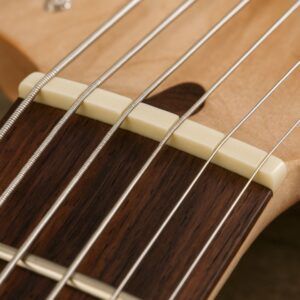
So, how to choose the perfect nut material for your electric guitar? Let’s break down the options, compare the pros and cons, and help you decide what suits your sound and style.
** Here’s a little transparency: Our website contains affiliate links. This means if you click and make a purchase, we may receive a small commission. Don’t worry, there’s no extra cost to you. It’s a simple way you can support our mission to bring you quality content.**
As an Amazon Associate, I earn from qualifying purchases.
What Does the Nut Actually Do?
The nut is a small strip (usually made of plastic, bone, or synthetic materials) slotted to guide each string from the fretboard to the tuners. It affects:
- String height and action
- Tuning stability
- String spacing
- Open string tone

In other words, the nut’s material and quality directly impact how the guitar feels and sounds — especially when playing open strings.
Does Nut Material Affect Tone?
Yes — but how much is often debated. The nut material primarily affects the tone of open strings. When you fret a note, the nut isn’t part of the vibrating length, so its influence fades. However, for open chords, slide playing, and unfretted runs, the nut’s tone contribution is real.
Different materials resonate differently:

- Harder materials like bone or TUSQ typically produce a clearer, brighter tone.
- Softer materials like plastic or cheaper synthetics may dampen or muddy the sound.
So, while it’s not as influential as pickups or amps, the nut still contributes to your guitar’s overall tonal signature.
What Is the Best Material for Electric Guitar Nuts?
There’s no one-size-fits-all answer, but here are the most common materials ranked by quality, tone, and performance:
1. Bone
- Tone: Bright, clear, and full — many describe it as the most “organic” sound.
- Durability: High. Bone wears slowly and maintains shape well.
- Used by: Many high-end guitars and traditional luthiers.
- Cons: Can be inconsistent due to natural variations, and harder to cut/shape.

2. TUSQ (Synthetic Ivory by Graph Tech)
- Tone: Very consistent, bright, and harmonically rich. Mimics bone without the inconsistency.
- Durability: Excellent. TUSQ is dense and resistant to wear.
- Used by: Many modern guitar manufacturers; common on mid to high-end models.
- Pros: Factory uniformity, no animal product, easy to work with.
- Is TUSQ Better Than Bone?
- If you value consistency, synthetic ethics, and easy installation, yes.
- If you prefer natural tone with traditional feel, bone still wins.
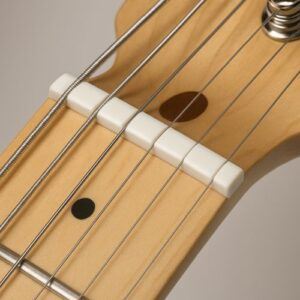
3. Plastic
- Tone: Dull, often lifeless compared to bone or TUSQ.
- Durability: Poor. Tends to wear fast and can cause tuning issues.
- Used by: Budget guitars.
- Pros: Cheap, easy to produce. That’s about it.

4. Graphite
- Tone: Slightly warmer than bone/TUSQ; reduces friction for better tuning.
- Durability: Very high.
- Used by: Players who use tremolo systems or need tuning stability.
- Pros: Self-lubricating, ideal for guitars with vibrato bridges.
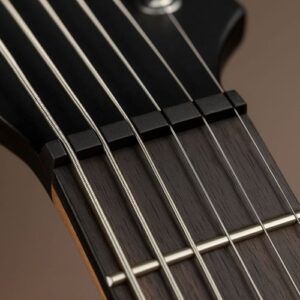
5. Brass
- Tone: Bright and metallic. Offers a very unique sound, especially for open strings.
- Durability: Extremely high.
- Used by: Experimental builders, custom guitars.
- Cons: Not everyone likes the tone; visually bold.

How to Choose a Guitar Nut That Fits You
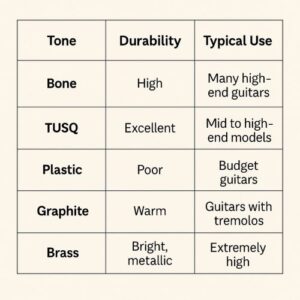
When deciding which nut material to use, ask yourself these questions:
- What’s my playing style?
-
- Slide players or open chord enthusiasts will benefit more from a higher-quality nut.
- Aggressive tremolo users may prefer graphite for its self-lubricating properties.
- Do I want traditional tone or modern consistency?
-
- Bone gives you a vintage, classic tone.
- TUSQ offers precision and consistency.
- Am I concerned with aesthetics or ethics?
-
- Bone is traditional but animal derived.
- TUSQ is synthetic and animal-free.
- What’s my budget?
-
- Upgrading from plastic to TUSQ or bone is a small investment that offers big tone rewards.
Final Thoughts…
Choosing the right nut material may seem like a small detail, but it can play a big part in your guitar’s tone, feel, and overall vibe. Whether you’re chasing vintage mojo with bone or going modern and clean with TUSQ, your nut choice sets the stage — literally — for everything your strings will do.
Still unsure? Start by checking what nut your current guitar has. If it’s plastic, replacing it with bone or TUSQ can be one of the simplest and most noticeable upgrades you’ll ever make.
If you’re in the early stages of your build, check out our Step-by-Step Guide To Building Your First Electric Guitar Kit to make sure your project gets off to a strong start.
Need help getting your strings dialed in after the nut install? Our Setting Up The Bridge And Neck On Your Electric Guitar Kit guide walks you through the critical setup process.
And if your build hits a snag, don’t worry — the Troubleshooting Common Issues During Electric Guitar Kit Assembly page has your back.
Rock on, and choose wisely.
There are 100’s of ways you can build a business around your passion for guitar building.
Check it out…
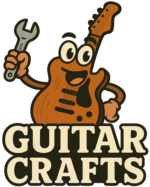



This is such a detailed and insightful guide on guitar nut materials! It’s fascinating how something so small can influence tone and playability in subtle but important ways. I especially appreciate the clear pros and cons breakdown—it really helps clarify whether to go with traditional bone or a synthetic like TUSQ.
I’m curious—do you find certain nut materials work better for specific genres or playing styles beyond what you mentioned? Also, for DIY builders, how tricky is it to swap out a nut material once the guitar is assembled?
Thank you so much! I’m really glad the breakdown helped! It’s wild how much that tiny piece at the top of the neck can shape the whole playing experience. Great questions! I do think certain materials pair better with specific styles… for example, bone tends to suit blues and classic rock players who want that natural, slightly gritty resonance, while TUSQ or Graph Tech options are great for metal or fast lead playing where consistency and tuning stability matter. As for swapping nuts post-assembly… it’s definitely doable, but it takes some care. I just changed one out on one of my personal guitars recently. Scoring around the edges and gently tapping it out works but fitting and filing the replacement properly is key. A nut file set is a good investment if you’re doing it more than once!
Great read — I never realized how much impact the nut material can have on open string tone and tuning stability. I like how you broke down the pros and cons so clearly, especially the comparison between bone and TUSQ.
Quick question: for a beginner upgrading from a stock plastic nut, would you recommend jumping straight to bone for tone, or starting with TUSQ for the easier consistency?
Thanks so much! I’m glad the breakdown made nut materials easier to understand. For a beginner upgrading from a stock plastic nut, TUSQ is often the easiest choice. It offers consistent performance, smooth tuning, and still improves tone noticeably. Bone can give slightly richer tone, but it’s a bit less forgiving when it comes to shaping and installation.
Starting with TUSQ lets you enjoy the upgrade without extra hassle, and you can always experiment with bone later once you’re more comfortable with setup.
Thanks again,
~Wayne
Up until now I never gave the type of material used for a nut any thought. I have replaced nuts on 2 of my acoustics but I’ve always used bone. I think I’ll at least give the graphite a try, the music store is less than a mile away!
I learned something! Great article!
That’s awesome to hear! Bone is a solid choice and has been the go-to for a long time, but graphite is definitely worth trying! It can really help with tuning stability, especially if you do a lot of bending or use a tremolo. Since your music store is so close, it sounds like the perfect opportunity to experiment. Glad the article gave you something new to think about!
Enjoy the upgrade and have fun hearing the difference!
Thanks,
~Wayne